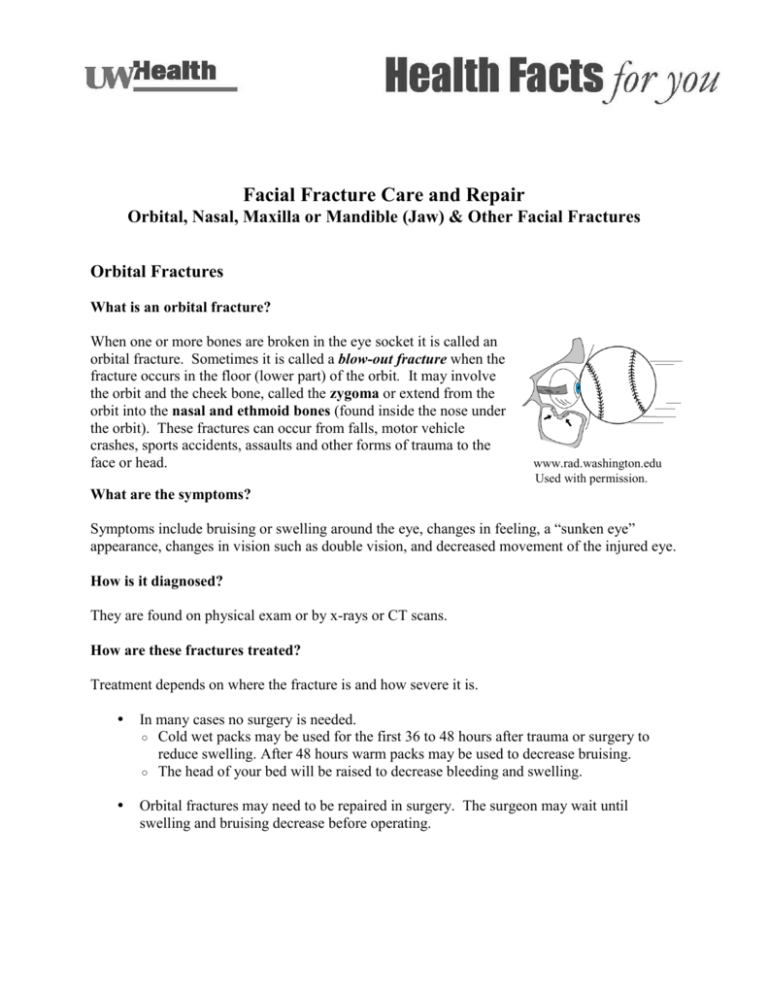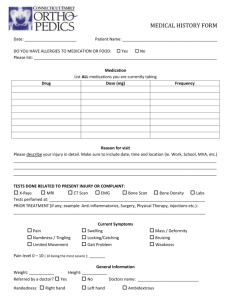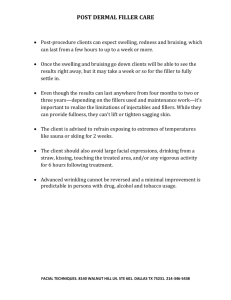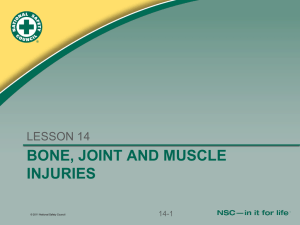
Facial Fracture Care and Repair
Orbital, Nasal, Maxilla or Mandible (Jaw) & Other Facial Fractures
Orbital Fractures
What is an orbital fracture?
When one or more bones are broken in the eye socket it is called an
orbital fracture. Sometimes it is called a blow-out fracture when the
fracture occurs in the floor (lower part) of the orbit. It may involve
the orbit and the cheek bone, called the zygoma or extend from the
orbit into the nasal and ethmoid bones (found inside the nose under
the orbit). These fractures can occur from falls, motor vehicle
crashes, sports accidents, assaults and other forms of trauma to the
face or head.
www.rad.washington.edu
Used with permission.
What are the symptoms?
Symptoms include bruising or swelling around the eye, changes in feeling, a “sunken eye”
appearance, changes in vision such as double vision, and decreased movement of the injured eye.
How is it diagnosed?
They are found on physical exam or by x-rays or CT scans.
How are these fractures treated?
Treatment depends on where the fracture is and how severe it is.
In many cases no surgery is needed.
○ Cold wet packs may be used for the first 36 to 48 hours after trauma or surgery to
reduce swelling. After 48 hours warm packs may be used to decrease bruising.
○ The head of your bed will be raised to decrease bleeding and swelling.
Orbital fractures may need to be repaired in surgery. The surgeon may wait until
swelling and bruising decrease before operating.
Broken Nose or Nasal Fracture
What are nasal fractures?
A nasal fracture or broken nose is the most common type of facial fracture. It occurs when
there is a crack or break in one of the two bones over the bridge of the nose. A more severe
fracture may extend into the orbit of the eye or through the ethmoid bone beneath the orbit.
These fractures can occur from falls, sports accidents, assaults, motor vehicle crashes and other
forms of trauma to the face or head.
What are the symptoms of nasal fractures?
Symptoms include pain, bruising, swelling or misshapen nose. The nose may have blood or
clear spinal fluid drainage from it. Other symptoms are bruising and swelling of the eyes and
trouble breathing through the nose.
How is a nasal fracture diagnosed?
A broken nose is found by physical exam or with an x-ray.
How are nasal fractures treated?
Treatment depends on where the fracture is and how severe it is.
In many cases no surgery is needed.
○ Ice or cold packs will be applied to the injured area of your nose (15 - 20 minutes
each hour while awake to reduce swelling). Ice will be applied at least 3-4 times a
day for 2 days. The ice will be placed in a small plastic bag, with a towel between the
ice and your skin. After 48 hours warm packs may be applied to decrease the
bruising.
○ The head of the bed will be raised to decrease bleeding and swelling.
○ Sometimes the doctor will place soft gauze in the nose (nasal packing) to stop nose
bleeding.
○ If the nose is not in line, the doctor may straighten it by hand.
If plastic surgery is needed to repair the fractures, the surgeon may wait until swelling
and bruising decrease before operating.
Jaw Fractures
What is a fractured jaw?
A fractured jaw occurs when one or more bones are broken in the upper jaw (maxilla) or lower
jaw (mandible). Le Fort I, II, or III are names for fractures that involve the jaw. These
fractures can occur from falls, motor vehicle crashes, sports accidents, assaults, and other forms
of trauma to the face or head.
What are the symptoms of jaw fractures?
Symptoms include bruising, swelling, pain, and tenderness over the fracture site. There may be
numbness, cuts, bleeding, facial deformity, malocclusion (the feeling that your teeth don’t bite
together like they should), misalignment of teeth, and lost or loosened teeth.
How are jaw fractures diagnosed?
A broken jaw is found by physical exam or with an x-ray. Sometimes the fracture is seen on a
CT scan of the head, which was done for other purposes.
How are jaw fractures treated?
Treatment depends on the where the fracture is and how severe it is.
In some cases the jaws are immobilized for 1-8 weeks through maxillo-mandibular
fixation (MMF) where the jaws are lined up and arch bars (like braces) are put in place
and wired or rubber banded to keep your jaws shut. This allows the break to heal in a
correct manner.
Open reduction and internal fixation (ORIF) surgery may be needed for certain types
of fractures and more severe fractures.
Ice or cold packs will be applied to the injured area of your jaw (15 - 20 minutes each
hour while awake to reduce swelling). Ice or cold packs will be applied at least 3-4
times a day for 2 days after injury or surgery. The ice will be placed in a small plastic
bag, with a towel between the ice and your skin. After 48 hours warm packs may be
applied to decrease the bruising.
The head of the bed will be raised to decrease bleeding and swelling.
If you need surgery, the surgeon may wait until swelling and bruising decrease before
operating.
How are my teeth & mouth cleaned?
A children’s toothbrush, rinsed in warm water to soften will be used with toothpaste to
brush your teeth each morning, before bed, and after meals. The children’s toothbrush
works better than a soft toothbrush to remove bacteria, blood, mucus and other matter
that can cause infection or tooth decay. Toothettes (mouth cleaning sponges) do not
clean the bacteria and debris from teeth to prevent infection or decay after MMF or
surgery of the mouth.
Your mouth will be rinsed with saline (salt water) or a prescribed mouth wash after
injury, MMF, or ORIF.
How will I be fed?
Once you are cleared to drink, you will be given clear liquids. Next your diet will be
advanced to full liquids, then to the Wired Jaw Diet which is blenderized foods that
may need to be thinned with a little water or milk. The nutritionist will explain this diet
to you and give you information on how to make food for yourself that will be safe for
you to eat.
Cheekbone (Zygomatic) Facial Fractures
What is a cheekbone (zygomatic) fracture?
A zygomatic fracture is a fracture of the cheekbone caused by a direct blow to the cheek. These
fractures can occur from sports accidents, assaults, falls, motor vehicle crashes, and other forms
of trauma to the cheekbone.
What are the symptoms?
Symptoms include bruising, swelling, pain and tenderness over the fracture site. There may be
numbness, cuts, bleeding, and facial deformity. There may also be symptoms of orbital
fracture(s).
How are they diagnosed?
A broken cheekbone is found by physical exam or with an x-ray.
How are they treated?
Treatment depends on the where the fracture is and how severe it is.
In some cases no operation is needed.
○ Ice will be applied to the injured area of your nose (15 - 20 minutes each hour while
awake to reduce swelling). Ice or cold packs will be applied at least 3-4 times a day
for 2 days. The ice will be placed in a small plastic bag, with a towel between the ice
and your skin. After 48 hours warm packs may be applied to decrease the bruising.
○ The head of the bed will be raised to decrease swelling.
○ Other fractures may need surgery to repair.
○ The surgeon may wait until swelling and bruising decrease before operating.
When do I need to call my nurse or doctor?
Call your nurse or doctor if you have
Trouble breathing or start to choke.
Increased pain at the injury or surgical site.
A change in vision.
Numbness or tingling at the injury or surgical site.
What do I need to know before going home?
Special Health Facts for You (HFFY) will be reviewed with you to explain your discharge.
Who do I call for questions?
Call Dr. _________________ office @ 608-____________ 8:00-4:30 weekdays
After hours, on weekends, and holidays call UW Hospital Paging Operator at 608262-0486. Ask for the ________________Surgery doctor on call. Give your name and
phone number with area code to the operator. A health care provider will call you back.
If you live out of the area call: Toll free 1-800-323-8942
Your health care team may have given you this information as part of your care. If so, please use it and call if you
have any questions. If this information was not given to you as part of your care, please check with your doctor. This
is not medical advice. This is not to be used for diagnosis or treatment of any medical condition. Because each
person’s health needs are different, you should talk with your doctor or others on your health care team when using
this information. If you have an emergency, please call 911. Copyright ©11/2014. University of Wisconsin Hospitals
and Clinics Authority. All rights reserved. Produced by the Department of Nursing. HF#6773.






